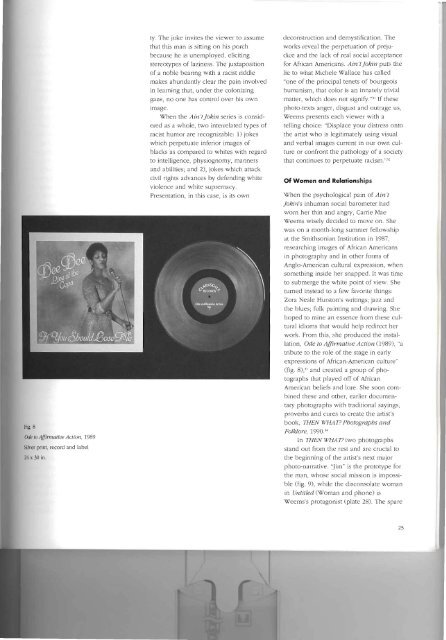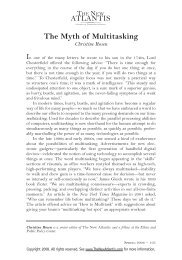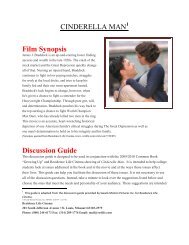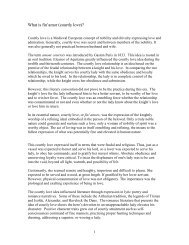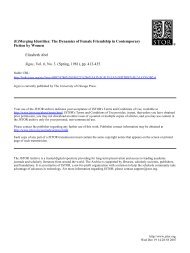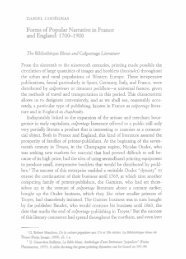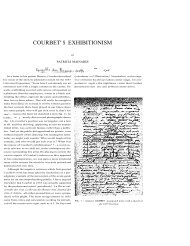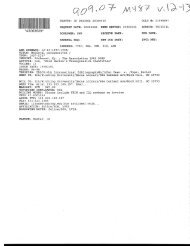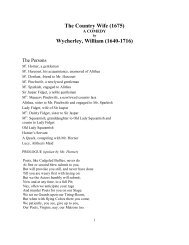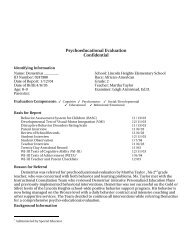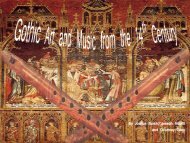CARRIE MAE WEEMS - People Search Directory
CARRIE MAE WEEMS - People Search Directory
CARRIE MAE WEEMS - People Search Directory
You also want an ePaper? Increase the reach of your titles
YUMPU automatically turns print PDFs into web optimized ePapers that Google loves.
Fig. 8<br />
Ode 10 A.01nnative Action, 1989<br />
Silver print. record and label<br />
24 x 30 in.<br />
ty. The joke invites the viewer to assume<br />
that this man is sitting on his porch<br />
because he is unemployed, eliciting<br />
stereotypes of laziness. The juxtaposition<br />
of a noble bearing with a racist riddle<br />
makes abundantly clear the pain involved<br />
in learning that, under the colonizing<br />
gaze, no one has control over his own<br />
image.<br />
When the Ain 'I jakin series is considered<br />
as a whole, two interrelated types of<br />
racist humor are recognizable: 1) jokes<br />
which perpetuate inferior images of<br />
blacks as compared to whites with regard<br />
to intelligence, physiognomy, manners<br />
and abilities; and 2), jokes which attack<br />
civil rights advances by defending white<br />
violence and white supremacy.<br />
Presentation, in this case, is its own<br />
deconstruction and demystification. The<br />
works reveal the perpetuation of prejudice<br />
and the lack of real social acceptance<br />
for African Americans. Ain't jakin puts the<br />
lie to what Michele Wallace has called<br />
"one of the principal tenets of bourgeois<br />
humanism, that color is an innately trivial<br />
matter, which does not signify."" If these<br />
photo-texts anger, disgust and outrage us,<br />
Weems presents each viewer with a<br />
telling choice: "Displace your distress onto<br />
the artist who is legitimately using visual<br />
and verbal images current in our own culture<br />
or confront the pathology of a society<br />
that continues to perpetuate racism. ".Il<br />
Of Women and Relationships<br />
When the psychological pain of Ain't<br />
jakin's inhuman social barometer had<br />
worn her thin and angry, Carrie Mae<br />
Weems Wisely decided to move on. She<br />
was on a month-long summer fellowship<br />
at the Smithsonian Institution in 1987,<br />
researching images of African Americans<br />
in photography and in other forms of<br />
Anglo-American cultural expression, when<br />
something inside her snapped. It was time<br />
to submerge the white point of view. She<br />
turned instead to a few favorite things:<br />
Zora Neale Hurston's writings; jazz and<br />
the blues; folk painting and draWing. She<br />
hoped to mine an essence from these cultural<br />
idioms that would help redirect her<br />
work. From this, she produced the installation,<br />
Ode to Affirmative Action (1989), "a<br />
tribute to the role of the stage in early<br />
expressions of African-American culture"<br />
(fig. 8),'\\ and created a group of photographs<br />
that played off of African<br />
American beliefs and lore. She soon combined<br />
these and other, earlier documentary<br />
photographs with traditional sayings,<br />
proverbs and cures to create the artist's<br />
book, THEN WHAT? Pbotograpbs and<br />
Folklore, 1990 .."<br />
In THEN 'WliA T? two photogra phs<br />
stand out from the rest and are crucial to<br />
dle beginning of the artist's next major<br />
photo-narrative. "Jim" is the prototype for<br />
the man, whose social mission is impossible<br />
(fig. 9), while the disconsolate woman<br />
in Untitled (Woman and phone) is<br />
Weems's protagonist (plate 28). The spare<br />
25


